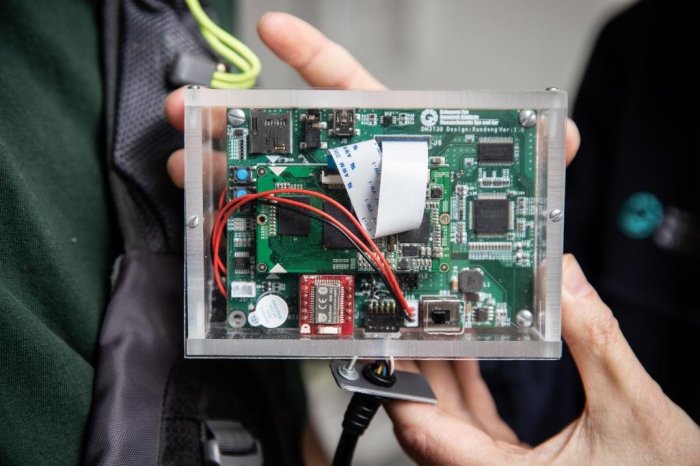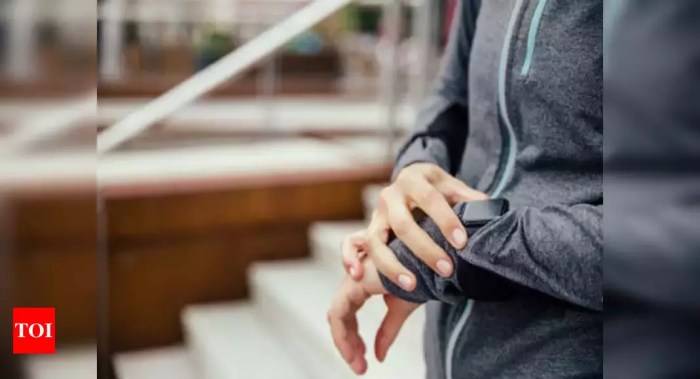Wearable Camera Technology
Imagine a world where visually impaired individuals can navigate their surroundings with confidence and independence. Wearable camera technology is making this vision a reality by providing real-time visual information to those who are blind or have low vision. These devices act as an extra pair of eyes, empowering users to detect obstacles, identify objects, and explore their environment with newfound freedom.
Types of Wearable Cameras
Wearable cameras designed for visually impaired individuals come in various forms, each with unique features and functionalities.
- Smart Glasses: These resemble regular glasses but incorporate cameras, processors, and displays to provide visual information. They can be used for object recognition, navigation, and even facial recognition.
- Cane-Mounted Cameras: These cameras are attached to the user’s white cane, allowing them to scan their surroundings as they walk. The captured images are processed and transmitted to a handheld device or a pair of headphones, providing audio cues about potential obstacles.
- Head-Mounted Cameras: These cameras are worn on the user’s head, similar to a helmet. They offer a wider field of view, capturing a panoramic view of the environment. The processed images are displayed on a built-in screen or through audio feedback.
Technical Features
Wearable cameras for visually impaired individuals incorporate sophisticated technology to capture, process, and present visual information.
- Image Sensors: These cameras typically use high-resolution image sensors to capture clear and detailed images. They often have wide-angle lenses to capture a broader field of view, improving situational awareness.
- Processing Power: The cameras are equipped with powerful processors that can quickly analyze images and extract relevant information. This enables real-time object recognition, obstacle detection, and other functionalities.
- Connectivity Options: Wearable cameras offer various connectivity options, including Bluetooth, Wi-Fi, and cellular networks. This allows them to communicate with smartphones, tablets, and other devices, enabling data sharing and remote control.
Examples of Wearable Camera Products
Several innovative wearable camera products are available for visually impaired individuals, offering a range of features and functionalities.
- OrCam MyEye: This device is a small, lightweight camera that attaches to the user’s glasses. It uses artificial intelligence to identify objects, read text aloud, and recognize faces.
- Aira: Aira is a smartphone-based service that uses a network of human agents to provide real-time visual assistance. Users can connect to an agent through a wearable camera and receive guidance on navigating their surroundings.
- Seeing AI: Developed by Microsoft, Seeing AI is a mobile app that uses a smartphone’s camera to describe objects, read text, and recognize faces. It also provides audio guidance for navigating unfamiliar environments.
Imagine a world where visually impaired individuals can navigate their surroundings with ease, confidently avoiding obstacles and hazards. Wearable cameras are revolutionizing the way blind and visually impaired people experience the world, providing them with a newfound sense of independence and freedom.
Real-Time Object Detection
Wearable cameras, equipped with advanced image recognition algorithms, act as “eyes” for visually impaired individuals. They capture real-time video footage of the environment, processing the visual information to identify objects, obstacles, and potential hazards. These cameras can detect a wide range of objects, including:
- People
- Cars
- Trees
- Steps
- Open doors
- Curbs
The ability to detect objects in real-time empowers visually impaired individuals to make informed decisions about their movement, ensuring their safety and independence.
Benefits of Wearable Cameras for the Blind
Imagine a world where navigating a busy street or crossing a crowded room is no longer a daunting task for the visually impaired. Wearable cameras, equipped with advanced technology, are making this vision a reality, empowering individuals with visual impairments to live more independently and safely. These devices act as extra eyes, providing crucial information about the surrounding environment, enhancing their ability to move freely and confidently.
Increased Safety and Independence
Wearable cameras offer a significant boost in safety for the visually impaired, enabling them to navigate their surroundings with greater confidence. These devices provide real-time visual information, allowing individuals to detect potential obstacles like steps, curbs, or moving objects, which might otherwise go unnoticed. By recognizing and alerting users to these hazards, wearable cameras significantly reduce the risk of accidents and falls. This increased safety fosters a sense of independence, empowering individuals to explore their surroundings freely and confidently.
Real-Life Stories of Empowerment, Wearable camera helps prevent the blind from bumping into objects
The impact of wearable cameras on the lives of visually impaired individuals is truly inspiring. Consider the case of Sarah, who has been blind since childhood. Before using a wearable camera, Sarah relied heavily on her cane and assistance from others to navigate her city. The constant fear of bumping into objects or getting lost in unfamiliar environments weighed heavily on her. However, after adopting a wearable camera, Sarah’s life transformed. The camera’s real-time visual information allowed her to identify obstacles and navigate independently, reducing her reliance on others and boosting her self-confidence. Now, Sarah confidently explores her city, enjoys social outings with friends, and participates in activities she previously thought were impossible.
Enhanced Quality of Life
The benefits of wearable cameras extend beyond safety and independence, impacting the overall quality of life for visually impaired individuals. These devices foster a sense of empowerment, allowing users to engage in activities they once thought were out of reach. Whether it’s attending a concert, exploring a museum, or simply taking a walk in the park, wearable cameras empower visually impaired individuals to experience the world more fully. This enhanced quality of life translates into increased social interaction, improved emotional well-being, and a greater sense of fulfillment.
Challenges and Limitations: Wearable Camera Helps Prevent The Blind From Bumping Into Objects
While wearable camera technology holds immense promise for enhancing navigation for the blind, it’s crucial to acknowledge the challenges and limitations that need to be addressed. These challenges are not insurmountable, but they require careful consideration and ongoing development to ensure the technology’s effectiveness and user-friendliness.
Privacy and Data Security
The use of wearable cameras raises legitimate concerns regarding privacy and data security. The constant recording of visual information raises questions about who has access to this data, how it’s stored, and whether it could be misused.
- Data Storage and Access: Ensuring secure data storage and access control is paramount. The technology should incorporate robust encryption and authentication measures to prevent unauthorized access to sensitive visual data.
- Data Usage and Sharing: Clear guidelines and policies need to be established regarding data usage and sharing. Users should have control over their data and be informed about how it’s being used.
- Data Retention: Determining the appropriate retention period for recorded data is essential. Deleting data after a specific period, unless explicitly required for specific purposes, can help mitigate privacy concerns.
False Positives and Accuracy
The accuracy of object detection and scene interpretation is critical for the effective functioning of wearable camera technology for the blind. False positives, where the system misinterprets objects or situations, can lead to confusion and potentially dangerous outcomes.
- Environmental Factors: The technology needs to be robust enough to handle varying lighting conditions, weather, and other environmental factors that can affect object recognition accuracy.
- Object Recognition Complexity: Distinguishing between similar objects, especially in cluttered environments, can be challenging. Further advancements in object recognition algorithms are necessary to enhance accuracy.
- Contextual Understanding: The system should be able to interpret the context of a situation, not just identify objects. For example, understanding the difference between a stationary object and a moving object is crucial for safe navigation.
Technological Limitations
Current wearable camera technology faces limitations in processing power, battery life, and user interface. These limitations can affect the real-world usability and practicality of the technology.
- Processing Power: Real-time processing of visual information requires significant computational power. Miniaturizing powerful processors while maintaining efficient energy consumption is a key challenge.
- Battery Life: Wearable cameras need to be energy-efficient to provide extended usage without frequent recharging. Advances in battery technology are crucial for improving battery life.
- User Interface: The user interface should be intuitive and accessible for users with visual impairments. Providing clear auditory feedback and tactile cues is essential for effective interaction with the technology.
Future Developments and Innovations
The world of wearable camera technology for the blind is poised for significant advancements, fueled by ongoing research and development. The integration of cutting-edge technologies like artificial intelligence (AI) and machine learning (ML) promises to revolutionize navigation for visually impaired individuals.
AI and ML algorithms can play a pivotal role in enhancing the functionality of wearable cameras for the blind. These algorithms can be trained to recognize objects, interpret scenes, and provide real-time information to the user. For instance, an AI-powered system could analyze a street scene and identify potential obstacles, such as parked cars or pedestrians, alerting the user through audio cues or vibrations. The system could also learn the user’s preferences and adapt its navigation suggestions accordingly.
Wearable Cameras with Haptic Feedback
Haptic feedback, which involves providing sensory input through touch, can be a valuable addition to wearable camera technology. Imagine a wearable camera that uses vibrations to guide the user around obstacles. This could be particularly helpful in navigating complex environments, such as crowded streets or busy intersections. Haptic feedback can provide a more intuitive and immersive experience, allowing users to perceive their surroundings more effectively.
Wearable camera helps prevent the blind from bumping into objects – Wearable cameras for the blind represent a significant leap forward in assistive technology, opening up new possibilities for independence and inclusion. As technology continues to advance, we can expect even more innovative solutions to emerge, further enhancing the lives of visually impaired individuals. The future holds immense promise for this field, paving the way for a world where everyone can experience the joys of exploration and interaction, regardless of their visual abilities.
Imagine a world where blind people can navigate their surroundings with ease, thanks to wearable cameras that detect obstacles. It’s a future we’re inching closer to, and while we’re waiting for that tech to become mainstream, some folks are already building their own Jurassic Parks, like this amazing father and daughter duo who spent a whopping $100,000 on LEGOs to recreate the iconic movie.
Perhaps, one day, we’ll see a LEGO Jurassic Park with a blind visitor experiencing the park in a whole new way, thanks to these life-changing wearable cameras.
 Standi Techno News
Standi Techno News

